12 How To Measure Wastewater Systems’ Sustainability?
Dariusz Latawiec
12.1 Introduction
Environmental pollution can be grouped into three main classes: water pollution, air pollution and soil pollution. Water pollution can originate from multiple sources, but common among them is wastewater discharged from domestic, agricultural or industrial facilities and processes. The management of domestic wastewater pollution is one of the targets of the European Council Urban Wastewater Directive (91/271/EEC). Pollution reduction can be achieved in different ways and the most commonly used strategy is the use of sewerage systems built in areas that meet defined criteria of technical and economic rationality. Processes of wastewater systems’ construction are quite advanced in the European Union (EU) but currently there is a big gap between Western and Central-Eastern EU regions due to financial reasons and historical political divisions. It is estimated that over 80% of the population of France is provided with sewers (wastewater system is in operation together with the proper treatment system) (Mascarau, 2008; Eurostat, 2014) compared to 97% in the United Kingdom, 94% in Austria and 96% in Germany both in urban and rural areas (Eurostat, 2014). The number of people connected to wastewater systems (also equipped with the proper treatment systems) has been very rapidly increasing in Poland in the past 10 years due to external financing by European funds. Yet only 65% of the population is served by sewers – out of which 89% is served in urban areas and only 30% in rural areas (Polish Chamber of Waterworks, 2013). It must be noted that in 2002 the total population served by sewers was 57% with 83% and 14% in urban and rural areas respectively. Where there are no sewerage systems usually septic tanks or small wastewater treatment facilities are used by the population. Both systems (small wastewater treatment plants and septic tanks) are difficult to regulate and can cause environmental pollution if not serviced properly. Therefore increasing the number of economically justified, well-designed and functioning wastewater systems is important for addressing environmental and sustainability challenges. Article 3 of the Urban Wastewater Directive points out that all agglomerations (as defined by the Directive, see below) should be provided with collecting systems for urban wastewater. If the establishment of a collecting system is not justified either because it has no environmental benefit or because it is associated with excessive cost, individual systems or other appropriate systems which can achieve the same level of environmental protection can be used. Although care should be taken with poor people, increased costs must not necessarily lead to unsustainability (given that the more affluent part of the population is willing to bear these costs).
The term “agglomeration” is defined as “an area where the population and/or economic activities are sufficiently concentrated for urban wastewater to be collected and conducted to an urban wastewater treatment plant or to a final discharge point” (European Council, 1991). The very definition of agglomeration has caused a problem in the Polish context. As it can be understood from the above, the wastewater systems should be built mainly in the agglomerations. The reasons for such an assumption are simple – only sufficiently concentrated activities will produce sufficient quantities of wastewater that would be economically justifiable to collect and treat in a single facility (wastewater treatment plant). The implementation of the definition of agglomeration in some cases resulted in perceived exclusion from the society, in particular in rural areas where wastewater systems would not be provided, as they were not considered an agglomeration (agglomerations were not established).
As a consequence, pressure was put on local authorities to include all areas and dwellings into the agglomerations, irrespective of the geographical conditions and distance from the main pipelines. Due to political and legal changes the established agglomerations were never properly verified by the higher level authorities. An effect of this is that the established agglomerations produced excessive costs of wastewater collecting systems that would have to be built in order to meet the Urban Wastewater Directive goals. In addition, Polish settlements and villages are more scattered than in some other EU countries and this could have been the reason for miscalculations of the agglomerations’ areas as well. These factors have led to “a bad use of a good science” – seemingly good implementation of the Directive has led to wrong actions. Thus a question is raised: whether the term “agglomeration” should rather be translated as “basin”?
Fig. 1 shows the schemes for sufficiently concentrated settlements, where establishment of the agglomeration would be relatively easy (Fig. 1a) and the examples of scattered settlements where agglomeration would probably not meet any economical standards (Fig. 1b).
It is only now, 10 years after the term “agglomeration” was firstly introduced in the Polish legal system, that the knowledge of the methodology for defining the borders of agglomeration properly becoming widely understood. The local authorities became aware that establishing agglomeration rationally requires a technical concept that has to be calculated, drawn and paid for. The population should be carefully assessed, as well as tourist activities and the amount of industrial loads must be known. The agglomerations established in the past as the effect of political decisions by the district council (the authority responsible for this initiative) are now being replaced by more rational and technical-based solutions.
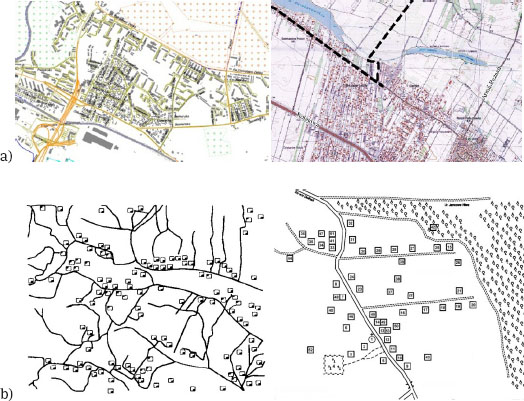
Figure 1: Concentrated (a) and scattered (b) settlements.
12.2 Indicators For Sustainability Assessment Of Wastewater System
The implementation of the Urban Wastewater Directive in the Polish legal system was done in a few Acts. One of the Acts was the directive of the Ministry of Environment concerning the methodology for establishing agglomerations’ borders. The Act adopted the definitions of agglomerations from the Wastewater Directive also introducing the methodology for defining which areas are sufficiently inhabited (concentrated) to justify wastewater system construction. It was stated that it was rational to construct sewerage only if the population density is 120 PE (population equivalent) for every kilometer of pipelines built (with a few exceptions defined in the Polish directive) (Polish Ministry of Environment, 2010). Such a statement has not appeared in the European Union Directive and was new to the Polish legal system. Currently, there is an ongoing discussion on whether such an indicator is needed and if it was defined properly. For the sake of this article it will be called population density indicator – PDI, and the population density will be stated as PD.
Some other indicators can be used to assess economic and/or technical rationality of wastewater collection systems. The most important economic indicators would cover the cost of wastewater system construction (investment) per capita, the annual maintenance costs per capita and the costs of household connection to wastewater system. The technical indicators could be defined as the collection and/or connection rate (the volume of sewage collected by a wastewater system compared to the volume produced by a population of agglomeration, the number of households connected to wastewater system compared to a total number of households in the agglomeration).
It may seem that the subject of sustainability should be quite obvious considering the abovementioned indicators. However, discourse on sustainability of sewerage is seldom on top of the agenda during various discussions in Poland. Sustainability of wastewater systems (both wastewater collection and treatment facilities) is considered a subject when technologies of renewable resources, water reuse, wastewater separation at the source or pollutants discharge loads minimization are taken into account (ISO, 2007). On the contrary, sustainability is not an issue when discussing economic justification of wastewater systems’ investments.
Considering the relatively low wastewater service availability (compared to other well-developed European countries) and a need for its increase, Poland is an interesting example to analyze sustainability and sustainability indicators in this sector of economy. Prior to joining the European Union in 2004, Poland had signed the Adhesion Treaty that imposed certain duties on Polish government. Environmental protection and control was one of the major issues and wastewater management was also included. Currently, there are vast investment works in wastewater systems all across Poland due to increasing pressure on the need to meet the Adhesion Treaty requirements in 2015. Wastewater pipelines were built covering several kilometers but the rationality behind some of them can be questioned. If an appropriate feasibility study had been performed the sustainability of such systems could have been undermined. The case study described here is therefore a good opportunity to observe, compare and analyze various effects (economic, technical, environmental, social) of a very rapid infrastructure growth and its impacts on sustainability of wastewater systems.
This chapter presents practical experiences of wastewater systems management in Poland. It aims to highlight sustainability issues by showing that some indicators, while commonly used, are sometimes significantly underestimated by decision-makers. The chapter shows that financial and technical guidelines for designing and constructing wastewater collection systems are practice-based and also illustrates the potential consequences of ignoring them.
12.3 Context Of The Case Study
All the examples in this chapter are taken from a company that manages wastewater systems in 10 southern Poland districts, Minor Poland province. All these Districts are characterized by rough alpine climate, mountain landscape, and are mostly rural areas. The Company deals with investment processes and every-day running activities of 16 small and middle-sized wastewater works and about 600 km of sewerage.
As discussed in the introduction to this chapter, the rationality of infrastructural investments should be that the pipelines are built in the areas with the highest population densities first. And only after those areas are successfully covered with wastewater collecting systems can areas of lower population densities be served. Unfortunately this logic often does not go together with the practice. The wastewater systems were built in quite remote and deserted spots and improperly established agglomerations have only enhanced such irrational activities.
Fig. 2 presents the pipelines that were actually built in one of the Districts managed by the Company. 600 meters of wastewater pipelines were built connecting six dwellings to a system. The resulting population density indicator was 40 PE/km and the costs were PLN 50,000 for each dwelling(€ 12,000, $ 16,700; 1 € =4.20 PLN, 1$=3.00 PLN). It must be pointed out that according to current Polish experience and engineering practice the rational cost of connecting sewage pipes to a single dwelling should be no more than PLN 15,000 (€ 3,570, $ 5,000). Also the cost of high quality on-site wastewater treatment construction is some PLN 15,000 in Poland. It is obvious that the realization of this investment is quite controversial.
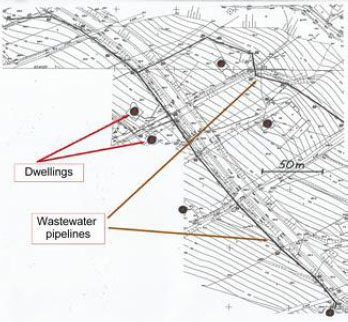
Figure 2: Wastewater pipelines in low concentration area, Minor Poland province.
On the contrary, Fig. 3 below shows a very rational concept of agglomeration borders where many dwellings had to be excluded from the agglomeration due to economic and technical reasons (Jazwiec, 2014).

Figure 3: The proposal of agglomeration borders (Jazwiec, 2014), Minor Poland province. The red area stands for agglomeration, the borders are very irregular to cover the areas of economic rationality only. Many dwellings had to be excluded for the agglomeration.
12.3.1 The Polish Tariffs System And Wastewater System’s Indicators
The “Polluter Pays Principle” is an environmental policy principle which requires that the costs of pollution be borne by those who cause it. Concerning the wastewater management, the general rule of “the polluter pays” is being realized by covering all and every costs during the process of calculating the tariffs. The principles of water and wastewater tariffs calculation are the subject of yet another Polish directive issued in 2006 (Polish Ministry of Infrastructure, 2006. Tariffs Directive). According to this directive the costs that have to be considered during tariffs calculations include: amortization (depreciation), taxes (land, property, income taxes and others), repairs and renovations, energy, materials, external costs, payroll, financial costs (interests), and any others that can contribute to overall costs of running all the activities (Polish Ministry of Infrastructure, 2006). Thus the tariffs are meant to cover not only running costs but all the investment costs and the costs of future reconstructions. And this should be treated as meeting the requirements of wastewater systems’ sustainability. The Company calculates ten separate wastewater tariffs (one tariff for each District) and draws ten separate investment plans (investments are also the subject of tariffs calculation).
However, this is theoretical and the reality is that due to the specificity of the Polish legal regulations, not all the companies in Poland include all the costs in tariffs. In addition, not all of the organizations responsible for water supply and wastewater collection are subject to the Tariffs Directive, which means that they do not have to include all the costs in tariffs calculation. This alone means that the systems in operation are not sustainable. The Company calculates the tariffs according to the Directive. The Company has completed the investment that was supported with a grant from the European Union of 17 million Euros (while the annual turnover of the Company was 3 million Euros at the time of the investment). The resulting costs of amortization and property taxes (assets-related costs) are now all calculated in the tariffs. The structure of costs by type is shown in Table 1. The table also shows the structures of some companies according to a benchmarking with which the Company is involved. It can be easily noticed that amortization and depreciation highly influence the overall costs of the Company, compared to the other organizations. This is a scale of indirect investment influence on tariffs. It can be seen how irrational investments can influence future tariffs for the whole community.
Table 1: The Company’s costs by type [%]. The columns “benchmarking I and II” show average values taken from two different benchmarks the Company is involved in. Benchmarking II contains more companies that have finished big investments, what can be observed by increased amortization and financial costs (loan interests) (Latawiec, 2014).

As a result of such a structure of costs as well as due to poor optimization of the investments in the past, the tariffs calculated by the Company for most of the Districts are quite high. In some of the Districts they can even exceed 3% of household’s available income. It is noted that 3% of household’s available income is the maximum to be paid by citizens for water and wastewater services (JASPERS, 2006). The situation is even more complicated due to the fact that there is a heavy touristic load on some of the areas covered by the Company activities and this generates some wastewater loads that are not simple to determine. The wastewater tariffs as well as some of the important factors influencing tariffs are shown in Table 2.
Table 2 shows some relations between tariffs and population density although the overall picture is blurred due to differences in amortization and investments realized in the past amongst the Districts. For example PDI is very similar in Districts 2 and 7 but the tariffs are much different and the reasons are differences in amortization and number of connections. Fig. 4 shows a visual interpretation of Table 2. As a very general rule one may note that the higher the population density the lower tariffs are. Of course lower tariffs are more acceptable by society.
Table 2: Tariffs for sewage services in 2014 and some characteristic factors in the Districts.
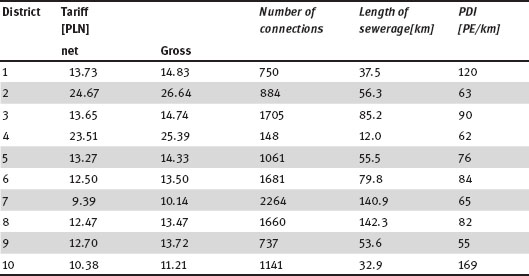
Therefore some selection and processing of data was made that included finding common cost factors all across the Company and considering the technological and technical specificity of wastewater treatment plants and investments realized in the past. As a result of data processing it was calculated that the running costs of wastewater collection alone is some 5,500 PLN/km (1,310 €/km) as average cost for the whole Company and all the Districts. Considering the costs of wastewater treatment the running costs are approximately 12,000 PLN/km (2,890€/km) of sewerage. These include the costs of minor renovations, energy, materials, payroll and do not include assets-related costs (amortization and property tax). These were calculated based on data available for the Company and should not be applied for any other organization. Furthermore, these costs will vary when the technologies within the Company change so they should not be applied even for the Company in the future should any major operational conditions change.
The above data processing and calculations allowed calculating theoretical tariffs that would be generated for any new wastewater pipelines built that would be only the function of the investment costs and the number of people using newly built lines. Thus the assets-related costs may be calculated from investment’s costs and any other costs would be calculated using the running costs as stated above. It was also assumed that the water consumption would be 2.5 m3/(PE* month). This is consistent with the long-term observations made within the Company.
The results of the calculations performed for the investments that had been already realized are shown in Fig. 5. The investments that are currently being done or are planned in the forthcoming years are shown in Fig. 6. The calculations were made according to the formula below:
![]()
where:
arc – annual asset-related costs calculated as investment costs multiplied by the factor 0.04 [PLN]
rc – annual mean running costs – here calculated as 12,000 PLN/km multiplied by the length of pipelines [PLN]
4 – number of inhabitants using a single connection to a system (people living in a dwelling) [persons]
2.5 – monthly consumption of water per person [m3/(person*month)]
12 – number of months per year [month]
Now it can be observed more clearly that the higher PE/km indicator is, the lower the tariffs are. Some exceptions can be observed and they are due to a large increase of investment costs caused by the obligatory roadwork. The preliminary thesis could be expressed:
- – if PDI (population density indicator) is some 100the PE/km, the tariffs would be some 10 PLN/m3,
- – if PDI is ≈ 50÷70PE/km, the tariffs would be some 15÷20 PLN/m3,
- – and of course if PDI is above 120PE/km, the tariffs would be below 10 PLN/m3.
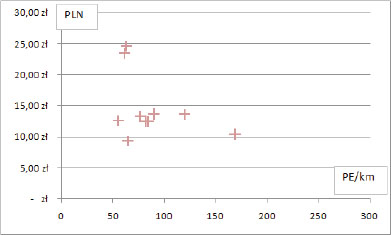
Figure 4: Relationship between wastewater tariffs and population density indicator. The X-axis shows Population Density Indicator (PDI) and the Y-axis shows tariffs level in PLN.

Figure 5: The relationship between wastewater tariffs (Y-axis) and Population Density Indicator (PDI on X-axis as population equivalent per km) – calculated for the investments finished by the Company in the past.
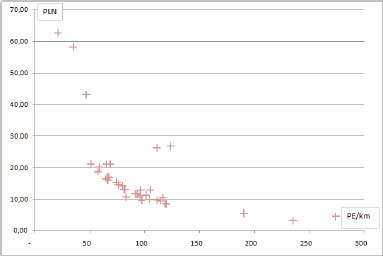
Figure 6: Relationship between wastewater tariffs (Y-axis) and population density indicator (PDI shown in PE/km) – calculated for the investments that have just been realized or are planned for tendering in the foreseeable future.
Fig. 6 shows the relationship between wastewater tariffs and population density indicator, calculated for the investments that are being realized or planned for realization. Due to a higher amount of investments the thesis postulated above can be clearly observed. All of the calculations were performed for the specific Company’s conditions and local determinants in the same manner as shown above. It must be pointed out that the lesser investment the more it is prone to disturbances, such as obligatory roadwork or necessity for wastewater pumping stations. Such situations can be observed in some cases where despite high PDI the tariff is high due to necessity of pumping station). Also the investments can be very easily rationalized. Sometimes it is enough to reduce the investment scope by one or two elongated pipelines (usually connecting individual dwellings) to increase PDI and reduce wastewater tariff. Such optimizations should be every-day practice during investments planning, tendering and realization.
Analyzing Fig. 6 the tariff-rules seem to shape as follows:
- – if PDI is ≈ 50÷70PE/km, the tariffs would be some 15÷20 PLN/m3, or even more
- – if PDI is ≈ 80÷110PE/km, the tariffs would be some 10 PLN/m3,
- – if PDI is ≈ 120 PE/km or more, the tariffs would be lower than 10 PLN/m3, and the higher the indicator is the lower the tariff.
The question arises now whether such relationships would occur all across the country. Analyzing various data sources (Polish Chamber of Waterworks, 2012, http://www.cena-wody.pl, http://www.cenywody.pl) it seems that intensive investments conducted on rural areas in conjunction with the assets assigned to companies (and not to districts or other local authorities) may contribute to tariffs increase. This seems to be a general rule with the exception as below.
In the case of suburbs and rural areas adjacent to bigger towns or cities where the tariffs are calculated altogether, the above-mentioned principles will not necessarily hold true. The mechanism of costs subsidizing occurs, which means that inhabitants from city centers pay a bit higher wastewater prices in order to keep a bit lower (than would be calculated) prices in the suburbs. One may assume that this would be the social cost of agglomerations’ development – if population of urban areas wishes to be provided with nearby ecosystem services such as leisure, greens, camping, etc., they would have to agree on paying more for wastewater services that would subsidize neighboring rural areas.
12.3.2 Household’s Available Income And Tariffs System
Household’s available income (or disposable income) is the amount of money that households have available for spending and saving after income taxes have been deducted. The available income varies depending on the region of Poland and on the size of city/town. It is assumed that water and wastewater charges combined should not be higher than 3% of household’s available income (JASPERS, 2006). It was calculated that available income in the region where the Company operates (southern Poland) and taking into account the size of settlements was PLN 913.58 monthly. This means that water and wastewater services expenditures should not be higher than PLN 27.41 per person per month.
Table 3 shows the expenditures for water and wastewater services per person as a function of tariff’s level and the difference between these costs and calculated 3% of available income. The negative values mean exceeding the 3% threshold and this means non-accomplishment of the very basic assumption – that the services should be financially available for the population. It was assumed that the typical water tariff is some 3.00 PLN/m3. But this figure will be lower for most rural areas due to individual water supply solutions, with the mean of 3.43 PLN/m3 for the whole of Poland (Polish Chamber of Waterworks, 2012). It must be also noted that the tariffs calculated above were given in net values and available income is given in gross values, which means that for the sake of comparability value added tax (VAT) had to be included.
Table 3: Available income vs. water and wastewater tariffs.
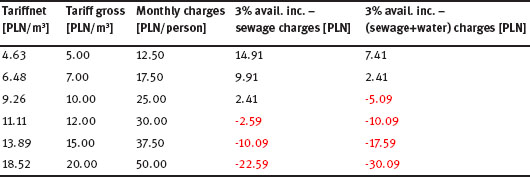
The conclusions from the above do not seem to be optimistic:
- 1. The high population density (PD=120 PE/km and more) will produce the overall tariffs of 5-7 PLN/m3 and this would include all the obligatory costs as specified in the Polish legal system. Unfortunately, such population density will be very rare to appear in rural areas.
- 2. The investment realization will produce the tariffs of 10 PLN/m3 and more in most of the Districts serviced by the Company.
- 3. The wastewater tariffs at the level of 10 PLN/m3, together with water tariffs can cause the charges for these services to exceed 3% of available income. Thus the completion of “the polluter pays” rule will cause this indicator of service availability to be exceeded.
- 4. The entire system sustainability achieved by the full realization of “the polluter pays” rule and covering of all the costs (including amortization, taxes, payroll, materials, and all others) leads to inability to provide wastewater services or its limiting in rural areas.
- 5. The abovementioned can lead in practice to:
- – abandoning of wastewater investments in rural areas,
- – worsening of environmental conditions due to a lack of rational and good alternatives for sewage collection and treatment systems (the septic tanks system does not meet the legal and environmental requirements in the Polish conditions for now).
- – the necessity of tariff subsidizing by the local authorities.
It should be emphasized very strongly that while the general conclusions drawn can be extended to other organizations, the specific numbers must be applied to the Company exclusively and having in mind the local conditions and factors. A change in any factor may lead to strictly different conclusions. Also note that the calculated available income at the level of PLN1,300 (310 €), as it was calculated for the other parts and regions of Poland(JASPERS, 2006), will cause different values in Table 5 and so the 3% threshold would not be exceeded for the tariffs as high as 12 PLN/m3.
12.3.3 And What Now?
Taking into consideration the conclusions above one should think of some means to change the current situation concerning rural areas. The most costs generating the tariffs arise from the assets-related costs amortization and depreciation and property tax. In some of the cases they will contribute to as far as 70÷80% of tariffs. What would the tariffs be if the assets-related costs were not included? The theoretical calculations are shown in Fig. 7. All the calculations were performed based on the Company situation, using the formula stated above and following all the abovementioned assumptions.
It is very clear that if the assets-related costs were not included into the calculation it is highly unlikely that the tariffs would exceed 10 PLN/m3 and even 7 or 8 PLN/m3 is reached in a couple of cases only. As it can be concluded from Table 3 only those cases can lead to overcrossing of 3% available income indicator. As a consequence it leads to the conclusion that if the assets-related costs were not included into tariffs calculation, the water and wastewater services availability would greatly increase. On the other hand, all the implications of such a paradigm shift must be clearly stated. Table 4 summarizes the most important implications of such a potential change in the calculation methodology.
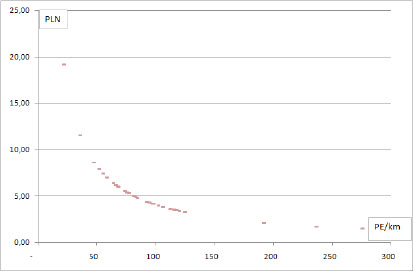
Figure 7: The wastewater tariffs (Y-axis) with the assets-related cost excluded (the costs of investments do not influence the tariffs).
Table 4: The consequences of a shift in tariffs calculation methodology.
| No. | Positive effects | Negative effects |
| Tariffs lowering, better services availability | Legal nonconformity – in the case of the Company (and any company based on the Polish commercial code) | |
| Decrease of potential environmental pollution | Funds collection for future reconstructions is not possible | |
| No need for subsidizing, will release some investment potential for the local authorities | Local authorities have to fund investments. | |
| Reduction of local communities’ tension and discontent | – |
It seems that there are social effects on the one hand and economic and environmental effects on the other. It has to be remembered that resigning of assets-related costs calculation must go along with the strategic planning of investment politics within districts. Abandoning of investments and renovations would lead to complete depreciation of all assets and negligence of their basic functions. And this would be a straight way to increase environmental pollution. Such situations have already occurred. The cases of investments finished 10÷20 years ago and then “forgotten” in operation are visible and are now subject of total modernization and renovation works.
The author of this chapter encountered various solutions for the problems stated above. The author’s personal opinion is simply that there is not a single or best remedy that can be unambiguously recommended. Most likely, a specific solution is highly dependent on local conditions, financial situation of districts and local authorities, wellness of community, or debt level of the organization responsible for water and wastewater systems operation. The current conditions of water and wastewater services in rural areas in Poland are quite disadvantageous – both for contractors (local authorities) and consumers. It seems that deep and essential system changes are necessary. If no changes are applied in the near future this may lead to a situation where services’ financial availability will be limited due to very high costs of water and wastewater services and this would lead to increasing loads of contaminants and nutrients discharged to the environment.
Also, a better caution should also be imposed on the use of alternative methods for sewage management, namely septic tanks and small wastewater treatment plants. Proper management and control systems should be introduced. It is very common that the so called septic tanks in rural areas are not sealed and/or they are emptied over the farmlands. These acts are of course forbidden but the lack of control systems allows for such practices quite often. The reason for such misdoings lies in the costs of proper septic tank management. Emptying and transporting of the full tank load to wastewater treatment plants would amount to some PLN 300 while the cost of spreading the content over the farmland is near zero. And this is why the amount of the sewage transported to wastewater treatment facilities from septic tanks is some 2% of the amount generated by the population. The law enforcement does not exist in this case (but this is the subject for yet another discussion). Taking into consideration some of the tariffs calculated in the tables above it has to be noted that some of them exceed 20÷30 PLN/m3. The prices for wastewater collection and treatment by the pipelines and by transport from septic tanks would be equal with the tariff of 35 PLN/m3. This would undermine the sensibility of wastewater pipelines construction and point the necessity of septic tanks management and control system – provided that the wastewater stored in them is transported to treatment plants.
As pointed above – all the services have a price. The price must be calculated rationally according to legal regulations and allowing to cover the expenditures borne by the investor. The realization of wastewater systems requires that beneficiaries of these systems cover the costs of the system. In the author’s understanding these should cover the running costs at least but full realization of the polluter pays rule will rather require that they cover investments costs as well. And this would lead to calculation of amortization into the tariffs too. Considering all the above, in the author’s opinion the demands of the Right2water initiative (e.g. guaranteed sanitation for all, global access to sanitation) would lead to unsustainability in water and wastewater services and failure in applying the polluter pays principle.
One has to be aware of the limitations of the method shown in this chapter. All the numbers, calculations and specific data are applicable for the Company alone and if such calculations were to be conducted for any other organization the specific numbers and values should be recalculated according to local conditions. Also, the described implications may not occur in towns or cities and in cases where the investments do not contribute to a major expansion of existing wastewater infrastructure or the communities are better-off.
12.3.4 Possible Recommendations
Based on the author’s experience, effects of the described situation and proposals for some changes that could lead to the increase of wastewater services availability are listed below. These should not be treated as the sole solutions nor the ones that would be successful in every situation.
- 1. The current model for tariffs’ calculation according to the Polish legal system may lead to an extraordinary increase of the costs that have to be covered by the end users. Therefore full realization of “the polluter pays” principle and achieving full sustainability of wastewater systems is a big challenge in rural areas.
- 2. It seems to be very rational that all the running costs are calculated (included) in the tariffs and this could be a measure for wastewaters’ systems sustainability. On the other hand, the decision whether or not the assets-related costs are included in the tariffs should be made by local authorities largely accounting for local conditions. Unfortunately this would require some changes in the existing legal system in order to cancel the necessity of assets-related costs calculations, in parallel with pointing out of sources for investment and reconstructions planning. Abandoning obligatory property tax calculation (2% of assets value) alone would lead to a remarkable tariffs decrease in some cases.
- 3. If the construction of wastewater collecting systems was to be fully sustainable and to cover all the costs of wastewater management, this may lead to tariffs increase beyond the level of social acceptability and financial availability. And this would cause maintaining the present, relatively high level of environmental pollution.
- 4. It seems that the population density indicator at 120 PE/km is quite rational. The investments realized at the areas of lower PDI may cause the increase of costs and tariffs and this could lead to crossing the limit of 3% of available income for water and wastewater services – as shown in the examples in this chapter. Of course PDI should be treated with care because in some situations even despite very low PDI the 3% limit would not be exceeded and therefore PDI can be treated as a very fast and auxiliary indicator of sustainability. Tariffs and economic availability of services (measured by percentage of available income spent on water and waste-water services) should be the ultimate indicators of sustainability.
- 5. This chapter shows the discrepancy between environmental effects of the investments in rural areas and the possibilities to meet all the related costs by the local communities. Clearly, the social costs are contradictory to environmental effects.
- 6. Cost balancing for large-scale systems (e.g. the province-scale, or more than one agglomeration) could lead to averaging the costs between cities and villages, lowering the tariffs in rural areas and thus increasing the accessibility of wastewater services.
- 7. Such solutions exist in Poland but they are quite rare. Such solutions may also be opposed because they do not really meet the “polluter pays” rule – citizens of higher population density areas would pay for those from rural areas – and nobody likes to pay for anybody else. Nevertheless tariffs calculation for wider areas covering a few cities/towns/agglomerations/villages could be beneficial for environmental protection.
- 8. As the matter of fact the current system of tariffs calculation in Poland makes it very difficult to assess the degree of sustainability of the infrastructure built due to the fact that environment-related decisions are sometimes taken without considering technical and economic aspects.
Having said that it may be beneficial for the local communities to have the wastewater investments completed by local governments and then handing the ready-for-operation assets over to managing organizations (assets-related costs would be omitted). Also individuals that are interested in collecting systems’ development could build pipelines under the supervision of a responsible organization and then hand them over to the organization.
As the ultimate solution, local subsidizing in any case when the tariffs exceed 3% of available income could be obligatory. Currently this solution is difficult to implement in some districts due to internal Polish regulations for financing and subsidizing local authorities. This solution would make the picture of sustainability even more frayed but the availability of the sanitation services would likely increase and so would the environmental gains.
12.4 Conclusions
The Company described in this chapter is a good example of the unwanted side-effects of environmental investments. The calculated tariffs are too high to bear by the local communities. It seems that maintaining the full sustainability of wastewater systems in the rural areas as shown in the chapter may cause tariffs increase to a level beyond social and financial acceptability. If the sustainability indicators as shown (PDI – population density indicator, available income) had been used and applied in a manner described in this chapter the financial and social problems could have been avoided. Alternatively, subsidizing or large scale cost balancing could be introduced but prior to this some law changes may be necessary.
Wastewater systems seem to be the best solution but the technical, technological, economic and legal issues must be strongly addressed. The use of septic tanks or small wastewater treatment plants will rarely secure environmental protection on the same level as wastewater pipelines connected to large-scale wastewater treatment plant.
References
European Council. (1991). Urban Wastewater Directive, 91/271/EEC
Eurostat. (2014). Population connected to urban wastewater treatment with at least secondary treatment, retrieved from http://ec.europa.eu/eurostat
International Standard Organization (2007). ISO 24511:2007 Activities relating to drinking water and wastewater services.
JASPERS. (2006). Guidelines for cost benefit analysis of water and wastewater projects to be supported by the cohesion fund and the European regional development fund (Polish edition) Jaźwiec, M. (2014). The agglomeration proposal for the district […].
Latawiec D. (2014). Wastewater systems – where to construct? Wodociagi i Kanalizacja, 7-8.
Mascarau, G.(2008). Le service public d’assainissement non collectif, retrieved from http://www.amf.asso.fr/document/index.asp?DOC_N_ID=8388&refer=http://www.amf.asso.fr/[recherche/resultat.asp?q=LE%20SERVICE%20PUBLIC%20D’ASSAINISSEMENT%20NON%20COLLECTIF
Polish Ministry of Infrastructure. (2006). Directive on tariffs (2006.127.886)
Polish Ministry of Environment. (2010).Directive concerning the methodology for establishing agglomerations’ borders (2010.137.922).
Polish Chamber of Waterworks. (2012). The tariffs for water services.
Polish Chamber of Waterworks. (2013). Water and wastewater infrastructure in Poland in 2012.
Water and wastewater prices, retrieved from http://www.cena-wody.pl
Water and wastewater prices, retrieved from http://www.cenywody.pl
